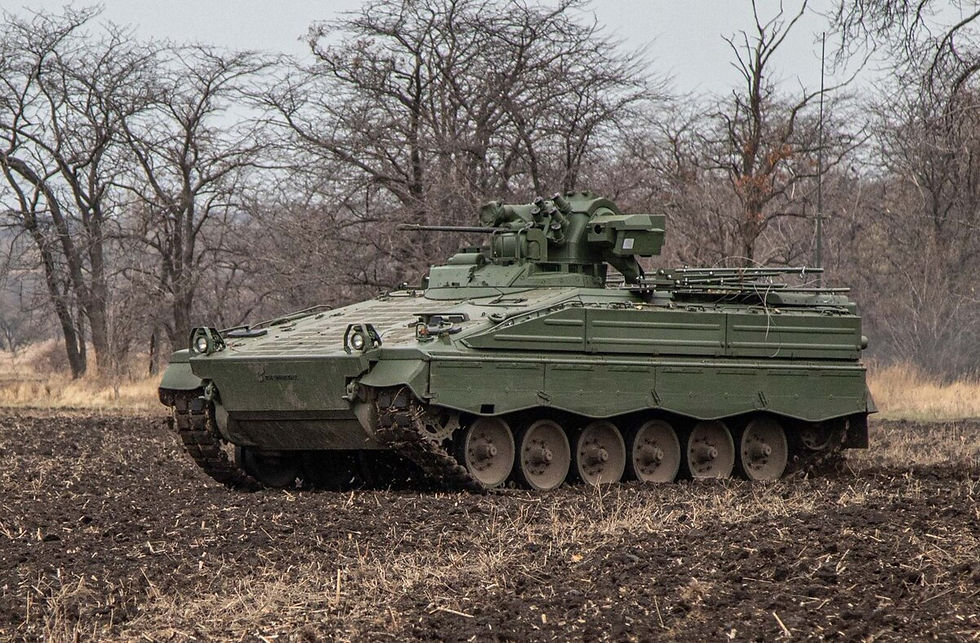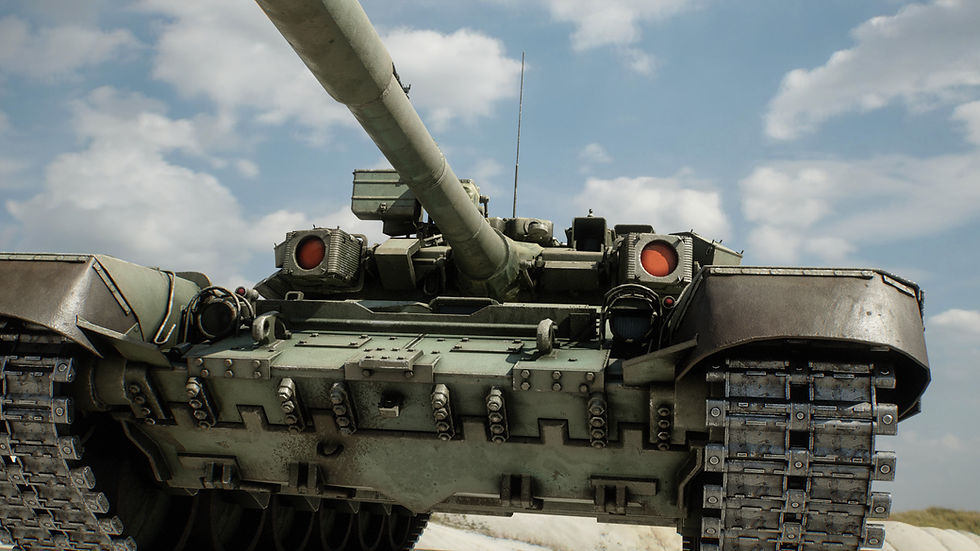The Marder IFV: From Cold War Defender to Ukrainian Battlefield Hero
- volkerbattke

- 1. Okt.
- 5 Min. Lesezeit
Experience German Engineering Excellence Through Advanced Simulation and Real-World Combat Performance
The Marder infantry fighting vehicle represents one of Germany's most successful military designs, a testament to robust engineering that has evolved from Cold War defender to modern battlefield warrior. Today, this veteran IFV not only serves Ukrainian forces in their fight for sovereignty but also lives on through cutting-edge simulation technology that allows enthusiasts and professionals alike to experience its capabilities firsthand.

Cold War Genesis: Engineering for Survival
Developed in the 1960s and entering Bundeswehr service in 1971, the Marder was Germany's strategic response to the Soviet BMP series. Named after the swift and agile marten, this infantry fighting vehicle was designed with a clear mission: survive and fight in the anticipated high-intensity battlefields of Central Europe during the Cold War's most dangerous decades.
The Marder's design philosophy prioritized crew protection, mechanical reliability, and sustained firepower over flashy technology or maximum speed. This conservative approach, sometimes criticized during peacetime, has proven remarkably prescient in the brutal realities of modern warfare, where dependability often trumps sophistication.
At 33.5 tons and measuring 6.79 meters in length, the Marder strikes an optimal balance between protection and mobility. Its tracked chassis provides excellent cross-country performance, while its relatively compact profile reduces its battlefield signature compared to larger contemporary designs.
Firepower That Delivers
The heart of the Marder's combat effectiveness lies in its 20mm Rheinmetall MK 20 Rh 202 autocannon, complemented by a coaxial 7.62mm MG3 machine gun. While the 20mm caliber might seem modest compared to the 25mm or 30mm guns found on newer IFVs, it has proven devastatingly effective against the mix of Soviet-era armor and improvised vehicles commonly encountered in modern conflicts.
The cannon's high rate of fire and excellent accuracy make it particularly effective against light armor, personnel carriers, and fortified positions. The dual-feed system allows crews to quickly switch between different ammunition types, adapting to changing tactical situations without lengthy reload procedures.
Germany's Commitment to Ukrainian Defense
Germany's decision to supply Marder IFVs to Ukraine marked a pivotal moment in post-war German defense policy. After initial hesitation, Germany committed to delivering approximately 40 Marder 1A3 vehicles, representing a significant shift toward active military support for Ukrainian sovereignty.
The delivery process, beginning in early 2023, included comprehensive training programs conducted by German instructors. Ukrainian crews learned not just vehicle operation but maintenance procedures, tactical employment, and integration with other Western systems – knowledge that would prove crucial in combat operations.
Battlefield Excellence in Ukrainian Service
Ukrainian forces have deployed their Marders across multiple roles, from direct infantry support to reconnaissance missions and rapid reaction operations. The vehicle's legendary reliability has earned particular praise from Ukrainian crews operating under challenging conditions with limited maintenance infrastructure.
Combat reports highlight the Marder's effectiveness against Russian light armor, including BMPs and BTRs. The 20mm autocannon's superior range and accuracy have allowed Ukrainian forces to engage enemy vehicles while remaining outside effective return fire range. Several documented engagements show Marders successfully destroying or disabling multiple enemy vehicles in single encounters.
The vehicle's survivability has proven exceptional, with multiple instances of Marders surviving direct artillery hits, mine explosions, and concentrated small arms fire. The robust armor protection, designed to withstand 14.5mm armor-piercing rounds frontally, has consistently protected crews even in the most intense combat situations.
Ukrainian commanders have particularly valued the Marder's ability to carry six fully equipped dismounts in addition to its three-man crew, enabling effective combined arms operations where infantry and armor work in close coordination.
Technical Evolution: The 1A3 Standard
The Marders supplied to Ukraine represent the 1A3 variant, incorporating decades of incremental improvements and battlefield lessons. Enhanced armor packages, improved fire control systems, and modernized crew stations make these vehicles significantly more capable than their 1970s predecessors.
Modern thermal imaging systems and digital communications networks have transformed the Marder from a Cold War relic into a contemporary fighting platform. These upgrades enable seamless integration with other Western systems, creating combined arms teams that maximize the strengths of different platforms.
Many Ukrainian Marders feature additional modifications specifically for their operational environment, including enhanced mine protection, improved NBC systems, and battlefield management networks that allow real-time coordination with other units.
The Digital Marder: Advanced Simulation Technology

Authentic Virtual Combat Experience
Our state-of-the-art Marder simulator model represents a quantum leap in military vehicle simulation, offering an unprecedented level of realism and detail. This isn't merely a static 3D representation – it's a fully functional virtual combat system that accurately reproduces the Marder's operational characteristics, tactical capabilities, and combat performance.
Comprehensive System Modeling
Realistic Weapon Systems: Experience the precise handling characteristics of the 20mm Rheinmetall autocannon, including authentic ballistics, ammunition selection, and fire control procedures. The simulation accurately models the weapon's rate of fire, recoil effects, and target engagement capabilities.
Authentic Mobility Dynamics: Navigate diverse terrain with realistic tracked vehicle physics that account for ground pressure, traction limitations, and cross-country performance. The simulation includes an accurate representation of the Marder's suspension system and handling characteristics.
Crew Station Accuracy: Operate from meticulously recreated crew positions, including the commander's station, gunner's position, and driver's compartment. Each station features authentic controls, displays, and operational procedures based on actual vehicle documentation.
Combat Systems Integration: Experience the complexity of modern battlefield management through integrated communications, target acquisition, and fire control systems that mirror real-world operations.
Training and Educational Applications
Progressive Skill Development: Begin with basic vehicle operation and advance through complex combat scenarios, following structured training programs that mirror real military instruction.
Tactical Scenario Library: Engage in historically accurate missions based on actual Marder operations, including Cold War exercises and contemporary Ukrainian combat situations.
Maintenance Simulation: Learn authentic maintenance procedures and troubleshooting techniques through interactive training modules that teach real-world mechanical skills.
Combined Arms Operations: Practice coordination with other military units through multi-platform scenarios that demonstrate modern combined arms tactics.
Historical Context Integration
The simulation includes a comprehensive historical background covering the Marder's development, evolution, and combat service. Users can explore the vehicle's Cold War origins, technical development, and contemporary battlefield applications through integrated educational content.
Professional Applications
Military academies, training institutions, and defense contractors utilize our Marder simulation for professional education and system evaluation. The model's accuracy makes it valuable for tactical training, crew familiarization, and operational planning exercises.
Strategic Impact and Future Relevance
The Marder's Ukrainian service has validated fundamental design principles while providing crucial combat data for future development. The vehicle's emphasis on crew protection and mechanical reliability has proven more valuable than initially anticipated, challenging assumptions about the necessity of constant technological advancement.
For Ukrainian forces, the Marder represents more than military hardware – it symbolizes international support and the enduring value of well-engineered systems. Crews have developed genuine affection for their vehicles, often personalizing them with Ukrainian insignia and names that reflect their adopted status.
Legacy of Excellence
The Marder's journey from Cold War sentinel to Ukrainian battlefield warrior demonstrates the enduring value of superior engineering and adaptable design. In the hands of determined Ukrainian crews, these German-built machines have found new purpose and renewed relevance, proving that sometimes the best solutions to modern challenges can be found in time-tested designs.
Through advanced simulation technology, the Marder's legacy extends beyond active military service, providing educational opportunities and preserving operational knowledge for future generations. Whether experienced through virtual reality or witnessed on actual battlefields, the Marder continues to exemplify the marriage of engineering excellence and tactical effectiveness that defines truly successful military systems.
The story of the Marder – both real and simulated – continues to evolve, but its contribution to military capability and educational advancement is already secure. This German veteran has adapted to new challenges and new operators, proving once again that superior design, properly implemented, transcends generational boundaries and geographical borders.









Kommentare